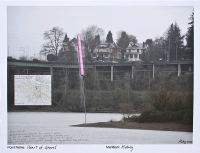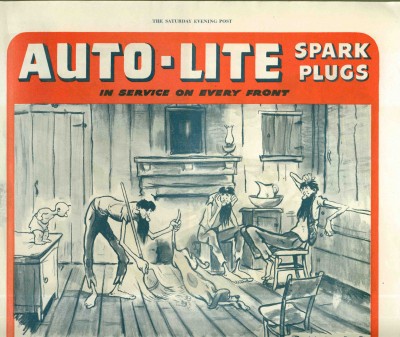Regionalism
The Portland Acupuncture Project

Kuby has a bunch of photoshopped pictures on his site showing what his project would look like, should it ever be completed.
Some of his other art proposals are interesting. For instance, I like his "Cliff Dwelling" idea, which would involve adding an artificial rock ledge to the side of a skyscraper as a nesting place for peregrine falcons. People could watch the birds from inside the building, but unlike a zoo the birds would be free while the humans would be confined. (Thanks to Cranky Media Guy)
Posted By: Alex - Wed Aug 20, 2008 -
Comments (1)
Category: Art, Medicine, Regionalism
Waterspouts
It's generally very pleasant living with easy access to the ocean, especially in summer.But yesterday, Rhode Island experienced some waterspouts.
A waterspout is basically when a tornado comes and sucks up swimmers and boats and brings them to Oz.
Such as in this video. But they escaped. (No flying monkeys were harmed in the filming.)
Posted By: Paul - Fri Aug 15, 2008 -
Comments (1)
Category: Boats, Nature, Weather, Regionalism
Follies of the Mad Men #12
Yes, I want my beer to be endorsed by a drunken chipmunk who's been taking fashion lessons from Andy Capp.Amazingly, despite this appalling choice of spokes-mammal, Stegmaier Beer remains in business to this day, as you can see if you follow the link.
Any reader ever tasted a "Steg"?
Posted By: Paul - Thu Aug 14, 2008 -
Comments (5)
Category: Animals, Business, Advertising, Products, Inebriation and Intoxicants, Regionalism, Comics
Follies of the Mad Men #9
[This image is from The Saturday Evening Post for May 5, 1945. As you can tell from the slightly mismatched borders, it's two separate scans, upper and lower, with the division just above the punchline caption. Excuse my impoverished Photoshop skills.]
Once upon a time, hillbillies were a powerful iconic staple of American life. But alas, no longer. Perhaps The Beverly Hillbillies was their dying gasp. Since then, PC guidelines no longer allow for such stereotypes, as the Abercrombie & Fitch folks found out a few years back, when they tried to market this T-shirt. And so our national mythology is a little drabber and duller.
Posted By: Paul - Sat Aug 09, 2008 -
Comments (5)
Category: Business, Advertising, Political Correctness, Regionalism, Television, 1940s
Spit-take
This fellow has many cuspidors.This museum actually wants them.
Two simple facts. Yet what a wealth of weirdness.
Posted By: Paul - Sun Jul 27, 2008 -
Comments (0)
Category: Agriculture, Customs, Eccentrics, Hygiene, Museums, Obsessions, Regionalism
Life Imitates The Simpsons: The Sip Joint
As anyone who has endured five minutes of conversation with me knows, I'll often relate real-life events to The Simpsons. That show, like the Bible and the works of Shakespeare, has now reached a canonical mass such that you may find a textual reference applicable to any real-world situation.Today's printed version of THE PROVIDENCE JOURNAL offers me another such occasion. There's an article headlined "Police Raid After-Hours 'Sip Joint' in Silver Lake." Inexplicably, though, this piece is not online, so far as I can google. But the barebones of the tale is told in a subheading. "A 17-year-old male who was allegedly caught dispensing beer has been referred to the Youth Services Bureau for prosecution in Family Court."
An older article which is still available gives us this definition of a "sip joint."
"A sip joint, according to the police, is a place where a bar is set up — usually a house — for the illegal sale of alcoholic beverages at times when bars are closed."
Now, I've often been strapped for cash, but I've never once thought of setting up a tavern in my residence. Yet to geniuses like Homer Simpson, such a plan is their first instinct, as we saw at the end of this episode.
The term "sip joint" itself seems exceedingly rare, and perhaps limited to Rhode Island.
Can readers supply instances of this practice, and what it's called, from their own regions?
Posted By: Paul - Fri Jul 25, 2008 -
Comments (18)
Category: Business, Crime, Stupid Criminals, Domestic, Inebriation and Intoxicants, Regionalism
The Old Leather Man
I'm eager to read The Old Leather Man when it appears in October from Wesleyan University Press. It sounds like prime historical weirdo material."In 1883, wearing a sixty-pound suit sewn from leather boot-tops, a wanderer known only as the Leather Man began to walk a 365 mile loop between the Connecticut and Hudson Rivers that he would complete every 34 days, for almost six years. His circuit took him through at least 41 towns in southwestern Connecticut and southeastern New York, sleeping in caves, accepting food from townspeople, and speaking only in grunts and gestures along the way. What remains of the mysterious Leather Man today are the news clippings and photographs taken by the first-hand witnesses of this captivating individual. The Old Leather Man gathers the best of the early newspaper accounts of the Leather Man, and includes maps of his route, historic photographs of his shelters, the houses he was known to stop at along his way, and of the Leather Man himself. This history tracks the footsteps of the Leather Man and unravels the myths surrounding the man who made Connecticut’s caves his home."
Posted By: Paul - Wed Jul 09, 2008 -
Comments (1)
Category: Eccentrics, Hermits, History, Historical Figure, Regionalism, Travel, Books

| Who We Are |
|---|
| Alex Boese Alex is the creator and curator of the Museum of Hoaxes. He's also the author of various weird, non-fiction, science-themed books such as Elephants on Acid and Psychedelic Apes. Paul Di Filippo Paul has been paid to put weird ideas into fictional form for over thirty years, in his career as a noted science fiction writer. He has recently begun blogging on many curious topics with three fellow writers at The Inferior 4+1. Contact Us |









